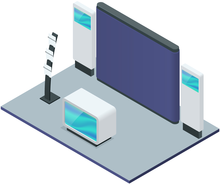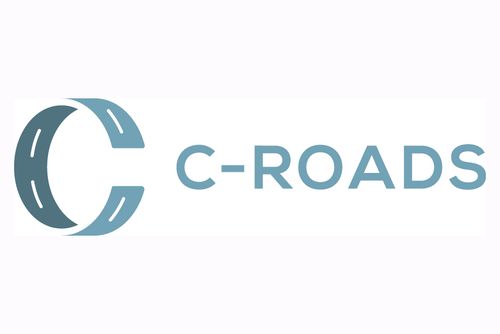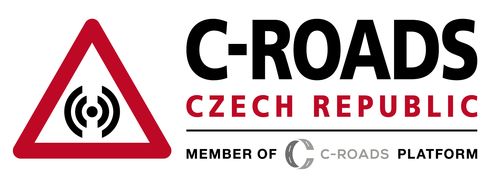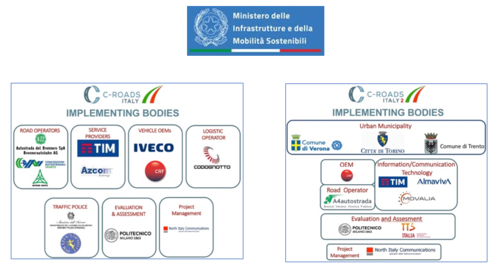Floorplan
Use the opportunity to meet up personally with those who implement C-ITS in the Member States of C-Roads and learn all details about how cooperative systems work in the respective environments. We will have numerous pilots with different approaches and preconditions, all of which have added up to the European harmonised deployment of C-ITS. Learn about the role of the European Commission and their undertakings to support C-ITS on political level or directly connect with crucial industrial stakeholders.

C-Roads France
Watch the introduction of the C-Roads France virtual stand here.
C-Roads France is a pilot to deploy and test C-ITS services. Implemented between 2016 and 2021, with a budget of 14 M€, it involves 13 partners: road operators and authorities, cities, car manufacturers, cyber-security providers, and research institutes. Services are supported by hybrid technology (ITS G5 and cellular). They are mostly oriented on road safety, but also cover urban use cases, urban/interurban interfaces, and in-vehicle traffic information (dynamic lane management). Today, 3000km of roads are equipped with ITS-G5 terminals. This represents 50% of the European road network. Partners have deployed about 150 road side units and 70 on board units on 4 sites in France. They have also developed a C-ITS smartphone application supporting early I2V services for roll up and further scale up.
APRR is the fourth-largest motorway group in Europe and the second-largest in France. It operates 2,323 kilometers of freeways in France and accompanies 23 million customers every year at every step of their journey, guaranteeing them the best conditions of safety, comfort and information. The company's 3,500 employees are involved in the day-to-day management of customer travel and safety. APRR offers a dense network in the middle of Europe. Its strategic position enables it to handle major commercial, tourist and home-work traffic on several roads.
Constantly improving the safety of our employees and customers is part of the DNA of our operating missions. These objectives are also those of cooperative intelligent transport systems, C-ITS. In 2016, APRR therefore decided to become a partner in the European C-ROADS project, the French declination of which is coordinated by the Ministry of Ecological Transition.
The five years of collaboration with our project's partners (LACROIX, Télécom Paris, Université Gustave Eiffel or even Transpolis) and C-ITS french specialists have enabled us to provide 90 km of connected highways today. We have commissioned an operational "Infrastructure-Vehicle" and "Vehicle-Vehicle" information exchange system. The connected vehicles can communicate directly with our traffic control center and our intervention vehicles such as patrol car, snow ploughs and movable light arrows. This is a full experience offered to car manufacturers who would like to finalize industrial tests, as well as a service in the making for our customers.
Télécom Paris is a member of IMT (Institut Mines-Télécom), a French public institution dedicated to higher education, research and innovation in engineering and digital technology. IMT is the leading of engineering and management schools in France. The group, which is made up of 13 public graduate schools, trains 13,000 students a year and fosters the production of value-creating research with 1,300 researchers and 1,600 PhD students. Télécom Paris is a founding member of the Institut Polytechnique de Paris, a world-class scientific and technological institution. Located at the Plateau de Saclay, this Institution is a partnership between Ecole Polytechnique, ENSTA Paris, ENSAE Paris, Télécom Paris, Télécom Sud Paris, with HEC as a key partner. Cybersecurity is a central focus for Télécom Paris and represents one of its research areas: Digital Trust. Security and safety are studied in all hierarchical levels of systems: from the physical layer to applications to mathematical tools, software layers, networks and societal aspects. Télécom Paris, in partnership with businesses and with support from Fondation Mines-Télécom, contributes to five chairs related to the field of cybersecurity in particular Connected cars and cybersecurity chair (C3S).
Télécom Paris is the leader of the security activity in C-Roads France Project. It is in charge of designing a secure and safe C-ITS ecosystem guarantying end-to-end security, trust, privacy and interoperability.



C-Roads Slovenia
Watch the introduction of C-Roads Slovenia here.
The C-Roads pilot in Slovenia formally started in 2016. The main objective was to deploy Day-1 C-ITS services using both short-range ITS-G5 and long-range cellular technologies. Implementing body of the pilot activities is DARS – Motorway operator in the Republic of Slovenia.
The C-ITS services were implemented on A1 motorway section between Postojna and Divača, which represents a part of the TEN-T core network. The pilot site was carefully chosen due to extreme weather conditions occuring especially during winter season (strong winds, sudden fog, snow storms) which in the past often led to the traffic accidents. Overall length of test site is 24 km, where 9 roadside units are installed on fixed positions. The roadside units are connected to the back-office located in Traffic Control Centre and Maintenance Centre Kozina.
Additionally, one mobile roadside station was prepared to broadcast C-ITS messages also in stand-alone mode (e.g. with trailers). The central application, running in the back-office allows triggering various C-ITS messages to realize use cases of HLN (Hazardous Location Notification), RWW (Road Works Warning) and IVS (In-Vehicle Signage) services according to the C-Roads harmonized specifications. In 2020, the roadside ITS-G5 infrastructure was upgraded and equipped with the PKI to ensure security in C-ITS communications.
Parallel to activities related to ITS-G5 roadside infrastructure, also the activities for upgrade of the ITS infrastructure and its integration for real time services have also been running. In 2019, the delivery of traffic information services in real time became operational.
Provision of real time traffic information supports Cloud Information Services. In 2017, the Cellular connected car activities started, resulting in Location-aware mobile application for end users, which was launched, successfully tested and evaluated in 2019.
The next steps of the C-ITS services deployment in Slovenia have been already in progress. In 2020, the pilot implementation of automatic transfer of traffic events from tunnel monitor and control systems into Traffic Information System was successfully implemented. Due to the positive results the project will be extended to the other regional traffic control centres including automatic transfer of traffic events from other traffic management and control systems as well. At the same time the roadside infrastructure will be upgraded by installation of additional ITS-G5 roadside units. The mobile application for end users will be updated with new features to improve user experience. In order to support hybrid C-ITS solutions, the C-ITS IP Basic Interface has been developed in 2021. Also the strategic repositioning of existing ITS systems has been started respectively.

C-Roads Austria
Watch the introduction of C-Roads Austria here.
The C-ROADS Austria “virtual” stand will give you an overview on the first operational, large-scale C-ITS rollout in Europe – consisting of three interconnected deployments on Austria’s motorway network, carried out by ASFINAG, the Austrian motorway operator.
This rollout, which started in 2020, includes:
- A central C-ITS unit in the traffic management centre
o disseminating C-ITS services from the C-ROADS catalogue
roadworks warning
hazardous location notification
in-vehicle signage
o using a “hybrid” communication approach
providing the same messages over different ways of communication
short-range (via C-ITS roadside units using ITS-G5 technology)
long-range (for cellular communication providers)
- 525 C-ITS roadside units distributed on 2.250km of road network
o First deployment of 175 units in 2021
Corridor Vienna – Linz - Salzburg, around Graz and at several border
regions
o 100 additional units each year until full deployment of 525 is reached in 2025
- 25 mobile warning trailers
o All purpose mobile units including video, radar, travel time estimation and
C-ITS
o 16 trailers already in operation in early 2021
- 100 road operator vehicles
o Disseminating road operator / emergency vehicle uses cases
o 10 prototype installations in 2021 with full deployment in 2022
Please visit us virtually to hear more about it!



JRC - European Commission
Joint Research Center of the European Commission.





C-Roads Plattform
Watch the introduction of the C-Roads Platform Stand here.
The C-Roads Platform is a joint initiative of European Member States and road operators which are in the phase of installing C-ITS for the testing and operation of C-ITS Day-1 and Day 1.5 services. Pilot installations will be harmonised in light of cross-border interoperability based on cooperation within the C-Roads Platform. Key elements are the joint development of technical specifications that form the basis for all pilot deployments, as well as the commonly prepared cross-site tests to demonstrate cross-border interoperability of the deployed C-ITS services.
The general C-Roads stand is your go-to-point for diving into the C-Roads Platform environment and discover what was achieved in the past five years. You will get an overview about the benefits of the platform construct and how the organisational and technical working groups interact. Ask our colleagues on site for a detailed introduction to the Working Groups and Task Forces of the C-Roads Platform and learn how we are ensuring interoperability through cross tests. Take a look into the future with us and see how the evaluation results are influencing deployment and roll-out of C-ITS in Europe for the next years.



C-Roads Czech Republic
Watch the introduction of the C-Roads Czech Republic stand here.
C-Roads Czech Republic project is a very good example of cooperation between public, academic and private sector. It is specific for the C-Roads Czech Republic project that it does not target only on motorways but also on cities, public transport and railway level crossings. The cities of Brno, Ostrava and Pilsen are among the first European cities where C-ITS has been fully implemented. In the same way, first trams and first railway level crossing signalling systems in Europe were equipped with C-ITS technology as part of the Czech C-Roads pilot. The decision to build a fully hybrid system (using two transmission technologies - ITS G5 and mobile operator networks on LTE technology) led Czech pilot site to a unique open architecture of the entire system covered by a dedicated integration platform, which is ready to connect different service providers. C-ITS was successfully deployed and has been ready for testing since spring 2020. It is the aim of the Czech authorities to further support and spread C-ITS across the country so that every road user can benefit from the work started by the C-Roads project.


C-Roads Germany
Watch the introduction of the C-Roads Germany virtual stand here.
C-Roads Germany is one of 18 national pilots which trial cooperative services in a real traffic environment. Germany as Member State contributes to the C-Roads cooperation by the results of the implementation and operation of in total eight different Day 1 C-ITS services (PVD, RWW, TJW, GLOSA, EVA, MVW & IVS) by using ETSI ITS G5 communication. In addition, the broadcasting of RWW via DAB and the display of GLOSA on a smartphone app were realised. These services were implemented and are in operation in two different pilot sites (Hessen & Lower Saxony). At the virtual stand you will receive information about the services implemented in Germany.
Furthermore, you can exchange information with the pilot partners about the test experiences and implementations. For more information: www.c-roads-germany.de


CAR 2 CAR Communication Consortium
Watch the introduction of the C2C virtual stand here.
Enhancing road safety and traffic efficiency by means of Cooperative Intelligent Transport Systems and Services (C-ITS) is the dedicated goal of the CAR 2 CAR Communication Consortium. The industrial driven, non-commercial association was founded in 2002 by vehicle manufacturers affiliated with the idea of cooperative road traffic based on Vehicle-to-Vehicle Communications (V2V) and supported by Vehicle-to-Infrastructure Communications (V2I). The Consortium members represent worldwide major vehicle manufactures, equipment suppliers and research organisations. Over the years, the CAR 2 CAR Communication Consortium has evolved to be one of the key players in preparing the initial deployment of C-ITS in Europe and the subsequent innovation phases. CAR 2 CAR members focus on wireless V2V communication applications based on Direct Short Range Communication (DSRC) and concentrate all efforts on creating standards to ensure the interoperability of cooperative systems, spanning all vehicle classes across borders and brands.



InterCor
Watch the introduction of the InterCor stand here.
“Interoperability”; it is a word one finds almost in every publication about C-ITS. However, by only writing about the importance of it, we will never reach a situation, in which C-ITS systems function cross-border throughout Europe. InterCor was a C-Roads Action focusing not only on finding (theoretical) agreements on C-ITS standards and the use of them (profiles), but also on testing these, cross border in real live - on the road - situations.
InterCor organized five so-called “TestFests” on pilot sites near Dordrecht (NL), Reims (F), Kent (UK), Antwerp (B) and Helmond (NL). All TestFests were open, not only for the participants in InterCor, but also for all others who were interested to participate.
A large variety of organizations took the opportunity to test in practice whether their interpretations of C-ITS standards resulted in seamless communication and well-functioning C-ITS services. Among them were OEMs, suppliers, software companies, road operators, knowledge institutes and universities. They tested the interoperability of the ITS-G5 communication, security implementations and hybrid communication. And in this way also connecting the implementations in the C-ITS Corridor, SCOOP@F, the UK pilot site London-Dover and initiatives in Flanders (B). The lessons learned from the TestFests were an essential building block for the further alignment that was continued in the C-Roads Platform.


C-Roads Portugal
Watch the introduction of C-Roads Portugal here.
C-Roads Portugal is paving the ground for making Cooperative, Connected and Automated Driving a reality in Portuguese roads, framed by the overall approach of the C-Roads Platform. The project includes the deployment of 5 C-ITS macro pilot cases, aligned in the Portuguese section of the Atlantic Corridor, covering relevant sections of the core and comprehensive network and of its two urban nodes. Combined with the testbed pilot cases, the project is also developing the feasibility studies for large-scale deployment of C-ITS services, notably its long-term viability, cost-efficiency, governance, and business models. C-Roads Portugal started in 2017 and has been followed by Cooperative Streets, which started in 2019. This second C-ITS project, also closely linked with the C-Roads Platform, is taking Cooperative, Connected and Automated Driving into the urban environment in several Portuguese cities. Together, these two projects are contributing to develop, share and publish common technical specifications (including the common communication profiles), taking C-ITS one step further. Portugal is fully committed to C-Roads Platform and to the future of C-ITS, and has thus embraced the challenge to Chair the WG4 - Working Group Urban C-Its Harmonisation.



C-Roads Italy
Watch the introduction of C-Roads Italy here.
During the life time of the C-Roads Italy project many activities have been carried out in order to achieve new opportunities to exchange C-ITS messages between road operators and vehicles (I2V), as recommended by the “C-ITS Platform” of the European Commission. The content of this communication concerns the so-called “Day-1” services, i.e. safety-oriented notifications and messages that are generated by the road infrastructure and, properly “translated”, reach the vehicle via specially set up devices and systems.
These are mainly notifications on road works in progress, road signs and information as well as announcements of potentially dangerous areas due to other causes such as accidents, traffic jam, weather conditions, road hazards. Thanks to this communication the vehicle is seamlessly and precisely informed about what is happening around it and in front of it.
Such exchange of messages is granted through the adoption of a “hybrid communication system”: short-range communication including ETSI ITS-G5 DSRC (Dedicated Short-Range Communication) wireless technologies and long-range communication, based on cellular network infrastructures. Interoperability of C-ITS services is often a challenge. To deal with this issue, the different back-end systems are connected by an Interchange Entity through a standard interface named BI (Basic Interface).
At present, all three motorway operators have a C-ITS infrastructure capable of transmitting messages to properly equipped vehicles travelling along their respective road sections. In particular, Autostrada del Brennero is equipped with 63 antennas located along its 314 km; Autovie Venete is served by 22 antennas covering 48 km of network, while Concessioni Autostradali Venete – CAV S.p.A has installed 12 RSUs along the A57 Mestre ring road in a 16 km stretch. At present, the C-ITS server of each operator manages the dissemination policies of C-ITS messages along the respective motorway axis, activating the transmission of I2V communications in an area of interest according to the event, its location and the RSUs next to it. The C-ITS server also integrates a management web interface dedicated to the management and visualization of the events in progress on an interactive map and to the management of the C-ITS infrastructure.
Moreover, within C-Roads Italy two specific automated driving applications have also tested:
• Trucks Platooning 4 vehicles driving together in Platooning, receiving events from the infrastructure. Events like traffic jams or road works warnings are received and visualised into the vehicles HMI for the driver; that to react in advance and so to reduce the possible risks on road. In addition, the Platooning controller is able, with the driver acknowledgment, to automatically reduce the speed in case of an upcoming speed limit. Finally, a first “Interaction” between cooperative vehicles (trucks and cars) has been introduced, by informing the Platooning drivers to know when a cooperative car wants to enter the lane. This represent a first test of what the integrations between autonomous vehicles and smart infrastructure can be in the future.
• Highway Chauffeur Highway Chauffeur is a supervised automated driving functionality for passenger cars in motorways or motorway-like roads with velocities up to 130 km/h. Thanks to the C-Roads Italy pilot, this functionality can benefit from vehicle-to-infrastructure and vehicle-to-vehicle communication. The C-ITS Day 1 services has been declined to be used into the vehicles. Events like traffic jams or road works warnings are received and visualised into the vehicles HMI for the driver; that to react in advance and so to reduce the possible risks on road. Finally, a first “Interaction” between cooperative vehicles (trucks and cars) has been introduced, by informing the Platooning drivers to know when a cooperative car wants to enter the lane. This represent a first test of what the integrations between autonomous vehicles and smart infrastructure can be in the future.


C-Roads Spain
Watch the introduction of the Spanish Pilot here.
The Spanish C-Roads pilot is made out of five different pilots, each of them with their unique set of technologies and C-ITS services, and with the involvement of different partners. This heterogeneity is meant to cover a wide spectrum of use cases, for the sake of assessing the impact of connected mobility in many representative scenarios.
The five Spanish pilots are the following:
- DGT 3.0, located along the overall TEN-T road network in Spain with an extension of approximately 12,270 Km. It is deployed using cellular-based communication technologies (3G and 4G/LTE).
- SISCOGA Extended, comprehending the extension of an existing test site infrastructure located in the city of Vigo and its metropolitan area already prepared to test ITS-G5 communication technology around 150 Km.
- Madrid Calle 30, located along the road "Calle 30" in Madrid, with approximately 32 km. C-ITS services are being deployed using hybrid communication technologies.
- Cantabrian pilot, deployed along approximately 75 km at the north of Spain using hybrid communications.
- Mediterranean pilot, deployed along approximately 125 km at selected road sections located in Catalonia and Andalusia using hybrid technologies.
This set of pilots have been carefully chosen in order to verify interoperability at national and European level, as well as the added value of C-ITS services in different scenarios. 25 partners participate on the deployment: Public, regional and local authorities, Private companies, Associations, Universities and Research Centres.



NordicWay
Watch the introduction of the NordicWay Pilot here.
NordicWay is a collaboration between public and private partners in Finland, Norway, Sweden and Denmark. NordicWay aims at taking the piloted services as close to deployment as possible. NordicWay Pilots enable vehicles, infrastructure and network operators to communicate safety hazards, and other information from roads, between different stakeholders. NordicWay aims to scale up C-ITS services by supporting cloud to cloud hybrid communication.
Watch our videos and discover some of the C-ITS real-life pilot deployment and services. Services and choice of technical solutions aim at covering the whole Nordic network and have a potential to reach high penetration. NordicWay is contributing to C-ITS deployment in Europe for the benefit of European citizens. NordicWay 3 – Urban Connection, has more cities involved than the earlier NordicWay 2.
https://www.youtube.com/watch?v=YKThQQbGGFc
https://www.youtube.com/watch?v=IRNbpBbyYXY


